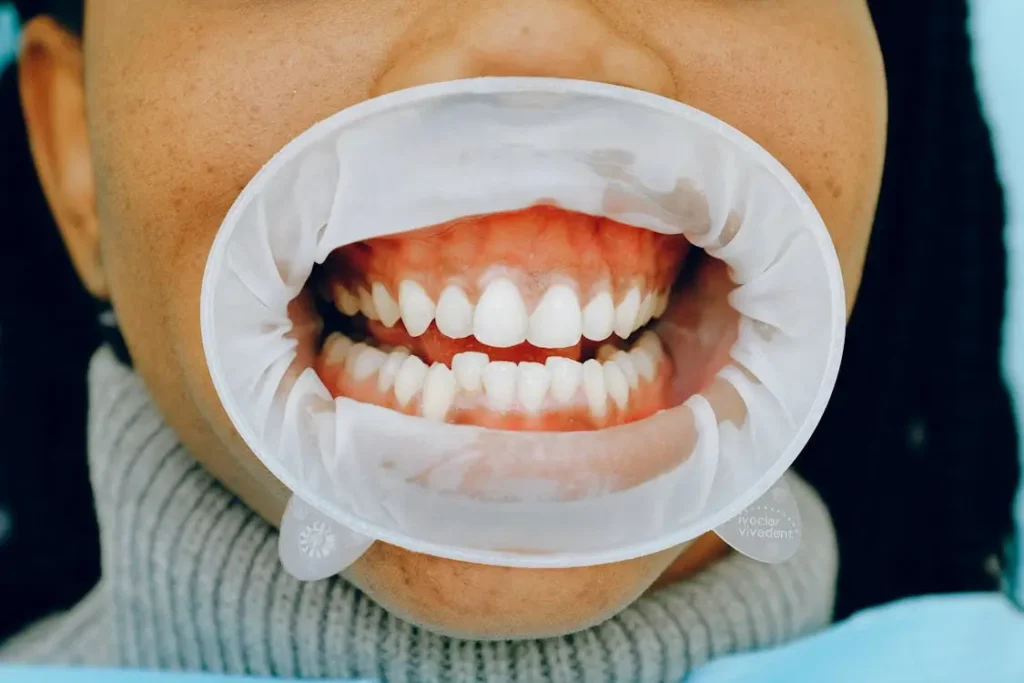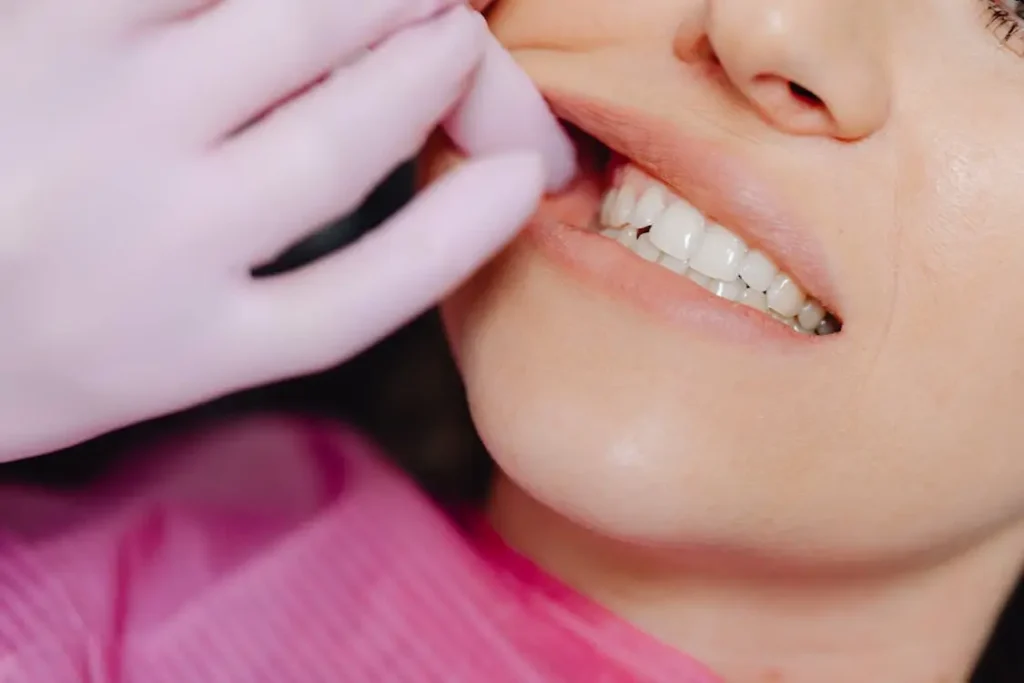
Imagine the foundation of your house — strong, secure, and holding everything in place. Now, picture that foundation slowly eroding, exposing the vulnerable parts of your home to the elements.
This is a powerful analogy for what happens when you experience receding gums. It's a common dental problem, often overlooked until it becomes more noticeable, where the margin of your gum tissue surrounding the teeth pulls back, exposing more of the tooth, or even the tooth's root.
At Council Oak Perio, we understand these concerns deeply and are here to guide you through the process of addressing receding gums and achieving a healthier smile.
Receding gums, also known as gingival recession, occur when the gum tissue pulls away from the teeth, exposing the roots beneath. It’s often a slow and gradual process, which is why many people don’t notice until it’s too late.
Unlike other dental conditions that cause immediate discomfort, gum recession tends to sneak up quietly.
Your gums play a vital role in anchoring and protecting your teeth. Think of them as the skin that keeps everything tucked in nicely.
They form a tight seal around your teeth, keeping harmful bacteria at bay. Once that seal starts pulling back, bacteria have a clear path to the roots—leading to decay, infection, and even bone loss.
One of the earliest and most noticeable symptoms is tooth sensitivity. When gum tissue wears away, the roots of your teeth become exposed. Since these roots don’t have enamel to protect them, even a sip of cold water can cause a sharp pain.
If your teeth appear longer than they used to, you might be dealing with gum recession. This visual cue happens when gums pull back and more of the tooth’s surface becomes visible. It may look like your teeth are growing—but in reality, your gums are shrinking.
Exposed roots are another telltale sign. You might notice a darker area near the base of your tooth, which can feel rough or sensitive to the touch. These roots are more prone to decay, especially without proper care.
Brushing your teeth too hard or using a hard-bristled toothbrush can wear down your gum line over time. While it’s important to clean your teeth thoroughly, using excessive force can actually damage your gums instead of helping them.
Gum disease is a major factor in gum recession. As bacteria accumulate along and beneath the gumline, they begin to destroy gum tissue and supporting bone. This leads to deep pockets forming around your teeth, making them vulnerable to movement and loss.
Inconsistent brushing, flossing, or skipping dental visits gives plaque and tartar time to build up. Once that happens, bacteria thrive—and your gums start paying the price. Maintaining good oral hygiene is essential for preventing recession.
Sometimes, it’s not about what you do—it’s about what you inherited. If gum disease runs in your family, you may be more likely to develop receding gums, even with proper care.
Smoking or chewing tobacco restricts blood flow to the gums, which slows healing and invites infection. Over time, this can contribute significantly to gum tissue loss.
Habitual grinding or clenching puts immense pressure on your gums and the bones supporting your teeth. This stress can cause gum recession, especially when done unconsciously during sleep.
Jewelry may look stylish, but when it rubs against your gums, it can cause irritation and wear away soft tissue. Over time, this can lead to receding gums in localized areas.
Fluctuations in hormones—such as those during puberty, pregnancy, or menopause—can make gums more sensitive and prone to recession. Women may notice increased inflammation and bleeding during these times.
Your Council Oak Perio periodontist will use a small probe to measure the depth of the pockets between your teeth and gums. Healthy gums usually have a depth of 1–3 mm, while deeper pockets may indicate gum disease or recession.
X-rays provide a clear picture of what’s happening beneath your gums. They help detect bone loss, one of the key indicators of periodontal issues contributing to gum recession.
Measuring pocket depth around your teeth is crucial. The deeper the pockets, the more likely you are to experience further gum and bone loss. Regular checkups can catch these changes early.
When gums recede, the stability of your teeth is compromised. If left untreated, this can eventually lead to loose teeth—or even tooth loss in severe cases.
Without the protective layer of gum tissue, your roots are exposed to bacteria and acids. This can lead to faster decay compared to the protected portions of your teeth.
Let’s face it—a receding gumline can change your smile. It may make your teeth look longer or uneven, which can affect your self-esteem and confidence when speaking or smiling.
This non-surgical treatment removes plaque and tartar from below the gumline. It helps gums reattach to the tooth surface and prevents further recession.
A gum graft uses tissue from the roof of your mouth or a donor source to cover exposed roots. It helps restore both function and appearance and can prevent further deterioration.
This minimally invasive method involves making a tiny hole in the gum tissue and gently repositioning it to cover exposed roots. It offers a quicker recovery time and less discomfort compared to traditional grafting.
These treatments help eliminate infection and reduce inflammation. They’re often used alongside deep cleaning or surgical procedures to support healing.
While proper care can stop recession from getting worse, gum tissue doesn’t grow back on its own. That’s why early detection and intervention are so important.
Non-surgical options like deep cleaning can manage mild cases. More advanced recession typically requires surgical methods like grafts or pinhole techniques to restore the gumline.
A soft toothbrush is gentle on your gums while still effectively removing plaque. Make the switch and brush with care—not force.
Use small, circular motions and hold the brush at a 45-degree angle to your gumline. Floss daily, but avoid snapping it into your gums—be gentle.
Antimicrobial mouthwashes can reduce bacteria. Fluoride strengthens your enamel and helps protect exposed roots from decay and sensitivity.
Seeing your dentist regularly ensures early signs of recession are caught and managed before they become serious.
A custom mouth guard worn at night can protect your teeth and gums from the pressure of grinding or clenching.
Your diet and general health impact your oral health. Eating foods rich in vitamins C and D, staying hydrated, and managing medical conditions like diabetes can help preserve your gum health.
Are you struggling to chew your favorite foods because of broken or missing teeth? Maybe you've just discovered that you have gum disease and aren’t sure what to do next. Or perhaps your smile has changed — with more gum showing, or not enough.
At Council Oak Perio, we specialize in personalized periodontal services. Dr. Christopher Bingham is a board-certified periodontist with over 20 years of experience helping patients overcome gum disease, bone loss, and smile imperfections.
Whether you're battling gum recession, a “gummy” smile, or just looking for expert guidance, you’re in the right hands.
Let’s work together to restore your gum health. Schedule your consultation today and reclaim your confidence.

Receding gums may seem minor at first glance, but they can lead to serious oral health issues if ignored. The good news is that with early diagnosis, lifestyle changes, and professional treatment, you can manage and even reverse its effects.
If you're dealing with symptoms like tooth sensitivity or longer-looking teeth, it’s time to take action. Talk to a professional, improve your daily habits, and seek the expert help of specialists at Council Oak Perio to protect your smile for the future.
No, gum tissue does not regenerate on its own. However, certain treatments like grafting can restore the gumline effectively.
The procedure is done under local anesthesia, so discomfort is minimal during the process. Some soreness afterward is normal but manageable with pain relief.
It varies depending on the cause. Gum disease-related recession can progress rapidly without treatment, while age-related recession is often slower.
Yes. When gums recede, bacteria can collect in the exposed areas, contributing to chronic bad breath or halitosis.
Without treatment, recession is typically permanent. But timely care can stop progression and even restore gum health with the right treatments.
If the recession is moderate to severe, it’s best to see a periodontist like Dr. Bingham. They have specialized training to treat and manage gum issues effectively.